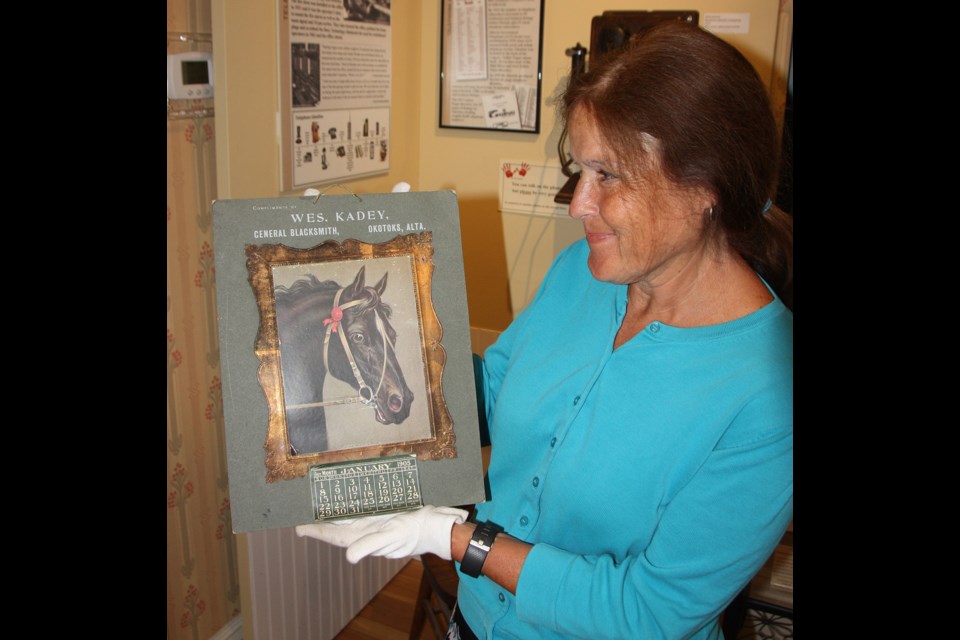While washboards and crank phones are popular relics of the past, artifacts unique to Okotoks tell the most about the town’s early years.
Among the Okotoks Museum & Archive’s 2,500 artifacts are a plethora of well-preserved and maintained items unique to the town, prompting historians to dig deeper into Okotoks’ history.
Some of museum specialist Kathy Coutts’ favourite artifacts are those obtained from the Okotoks Creamery, which operated from 1925 to 1969. The creamery closed following a decline in dairy farming and increased competition from large commercial creameries that made operating small independent creameries difficult.
During its operation, the butter-making operation relied on farmers to bring in a steady supply of cream and was capable of producing 1,500 pounds of butter daily.
While metal cream and milk cans are a popular find, the Okotoks Museum and Archives received one unique to Okotoks. The top is painted yellow with “A. Balderson” and “17” painted in white.
Coutts explained that each creamery had a colour they painted their cans and each customer was assigned a number. Al Balderson, a local milk farmer, was assigned 17.
“An object is just an object until you can get a local connection to it,” she said. “It makes it authentic.”
Historians discovered Balderson had moved to Okotoks and opened a milk farm after serving in the Second World War.
“This artifact is not just a cream can, it helps tell the story of the Okotoks Creamery and it helps tell the story of Al Balderson,” said Coutts. “It has character – the rust, the dents – it’s been well used.”
Another treasured artifact is a metal matchbox holder with an inscription that reveals it was a gift from creamery proprietor Neil Dorsey, who managed the business from 1926 to 1927 and owned it the following 18 years, and includes the creamery’s phone number - 7.
“This is merchandising that the business owner gave to loyal customers thanking them for giving them business,” Coutts said. “It helps tell the story of merchandising, of the creamery, even telephone history, all in one little artifact.”
The gift was well used.
“It has wear where the matches would have been struck on the side,” she said. “It has character.”
The museum also has a butter wrapper made of vellum paper boasting the label “Okotoks Brand Creamery butter,” which Coutts said won many awards for the best grade butter in Canada.
Artifacts dating back a century aren’t always easy to find, but the Okotoks museum has its share.
Among them is a 1905 calendar, a gift to someone from former blacksmith Wes Kadey.
“All of the pull-off months are still in tact,” said Coutts. “That’s remarkable, considering it’s 114 years old. It’s in excellent condition.”
Historians discovered Kadey moved to Okotoks in 1897 and opened a blacksmith shop on McRae Street immediately east of the Stockton Block. He served as a blacksmith, farrier, wheelwright and welder.
Kadey, who served as mayor and fire chief while living in Okotoks, practised his trade for 35 years until his shop, as well as the other four frame buildings on the street, were destroyed by fire.
Although the museum has calendars from King Drugs and the Wentworth General Store, Coutts said this one is, by far, the oldest.
Also dating back to the turn of the 20th century is a regulator clock, mounted on the wall behind the museum’s front counter, with the lettering “T.T. McKee Watchmaker and Jeweler.”
Research into T.T. McKee reveals he operated the business in Okotoks for a year in the early 1900s.
“He wasn’t in Okotoks for very long,” said Coutts. “I would imagine this hung in his store. It’s too beautiful to hide away so it’s permanently on display.”
While many artifacts are obvious heirlooms, one that caught Coutts by surprise was the donation of a paper flower bag from Okotoks’ Chinook Flour Mill, which operated from the late 1930s to 1948 in the historic brick building on the northeast corner of Elma Street and Veteran’s Way.
The business milled two grades of baking flour, Mountain Rose and Chinook’s Best, and supplied flour to Great Britain during the Second World War.
“Who would have thought to save this, but I’m glad they did,” said Coutts. “I’m very grateful that someone had the foresight that it might be historically valuable and hung on to it. It’s really special to our history in our community, as well as the impact on the rest of the world during World War II.”
From century-old clocks to flour bags, Coutts said she appreciates every artifact that’s donated to the museum.
“There comes a time when people are downsizing or clearing the home of parents or grandparents and it comes to the museum,” she said. “It’s amazing what people have kept. We are very fortunate people recognize the value to some of these things.”




